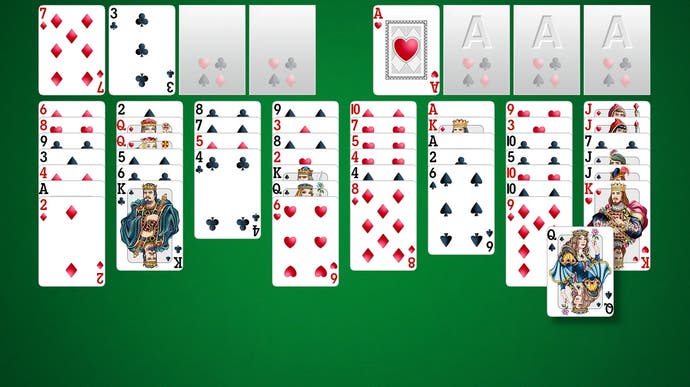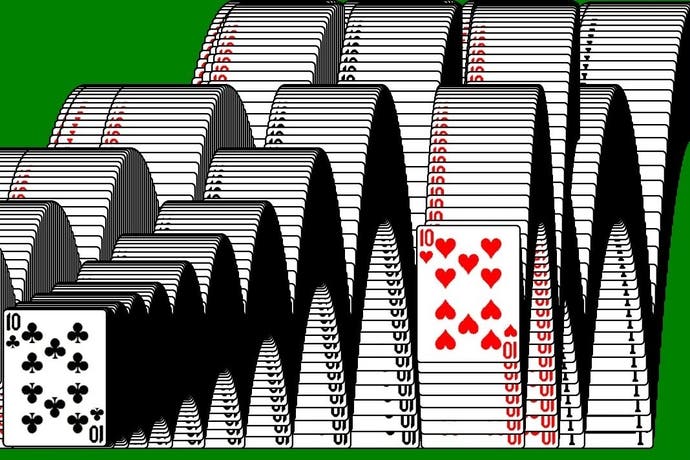Redesigning the world's most-played PC game
Patience is a virtue.
The most used piece of PC software in the world isn't Word, that blank slate on which countless novels, school projects, hot-takes and clipart collages have been tapped out across the years. It's not Excel, with its stretching and compressing cells, into which the world's companies daily deposit their vital statistics and forecasts. It's not even Steam, the portal that leads to millions of other virtual universes.
It is, according to a Microsoft employee, Solitaire, the card-clearing game of luck and watchfulness, which has filled the gaps in many an office worker's schedule since its Windows 3.0 debut in 1990. According to a 1994 Washington Post article, Microsoft executives hoped Windows Solitaire would teach PC users mouse fluency and, moreover, "soothe people intimidated by the operating system." Intimidation, it turned out, had little do to with it.
Alongside Minesweeper, that other ignoble time-waster which was, until recently, included in every fresh install of Microsoft's operating system, Solitaire (or at least those variations offered by the company; strictly the term refers to any game that can be played by one player, the antonym, if you will, to 'multiplayer') is probably the most widely played PC game of the past twenty-five years. And yet, despite its persistence - this is, after all, a game Napoléon Bonaparte was reported to have enjoyed during his exile at St. Helena in 1816 - Solitaire is seen as a base distraction.
In 2000, a New York Times profile of George W. Bush wryly mentioned that the then governor of Texas sometimes played it during a moment of downtime during the working day. Solitaire, the subtext goes, is not only a frivolous diversion but perhaps also a perilous one. Indeed, Dr. Maressa Hecht Orzack, an assistant professor at Harvard Medical School, opened the first clinic for computer addiction in 1996 after she became obsessed with beating her personal solitaire scoring record.
The disdain with which Solitaire, or Patience as it's known in Europe (both words have Latin roots; the Americans focus on the game's solitary nature and, perhaps, its jewel-like properties, the Europeans on the suffering involved in a game that falls apart in the final stages, and the virtue required to triumph), is held had become a source of irritation for game-designer Zach Gage.
"Solitaire is arguably one of the most widely played games of all time, yet it is relegated to the same category as junk time-wasters like Candy Crush," he says. "I wanted to see whether it is possible to redesign Solitaire in such a way that it retains its charm, but can become respectable and deep like its contemporaries Poker and Bridge."

Gage, a prolific game-maker who is best known as the designer of smartphone classic Spelltower and as the co-creator of Ridiculous Fishing, is attracted to this kind of conundrum. "When you set your sights on making something new out of something old, you get to explore spaces pre-packed with rich histories and cultures that you need to respect and play off - it makes for fascinating design problems."
Gage is not the first person to attempt to redesign Solitaire. The debut commercial computer-based solitaire collection, Solitaire Royale, written by Brad Fregger, which predated Microsoft's version by three years, contained eight different variations. 1992's MS-DOS game, Solitaire's Journey, contained 105. In the 1960s Paul Alfille, then a ten-year-old boy, designed a variant he dubbed Freecell. By 1979, he'd made a version for the computer network at the University of Illinois, PLATO, which helped his variation gain popularity in America.
But Solitaire rule-bending goes back much further than that. In 1874, Lady Codogan's book 'Illustrated Games of Patience' presented a number of variations, and more were added in subsequent texts such as William Dick's Games of Patience in 1883, and Professor Hoffman's Illustrated Book of Patience Games in 1892. The Complete book of Solitaire and Patience Games by Albert Morehead and Geoffrey Mott-Smith, first published in 1949, contains 225 variations. It is still in print to this day.

"Solitaire is the perfect target for re-invention because its genre is enormous," says Gage, "it's one of the most popular games of all time, and it literally may be the original mobile game - when it was first invented, women in Europe carried around lapboards to play on the go."
While Gage comes across as a Solitaire evangelist today, when he started his project he "never really honestly understood what people find enjoyable about the game." It seemed to require too much luck. In Klondike Solitaire, arguably the most popular variant today, you deal cards from a shuffled deck into a prescribed arrangement on a tabletop. You must then attempt to reorder the deck, arranging it by suit and rank via a series of moves transferring cards according to a set of strict limitations. The object of the game is to build four piles of cards, which move from ace to king in each suit, by removing relevant cards from the layout.
"Most solitaire variants are essentially complex puzzle-knots that are generated by the randomness of a shuffle," says Gage. "They take an unordered set of cards, and then ask you to order that set of cards through an incredibly complex mathematical set of rules. The 'variant' is the mathematical equation."
For Gage, the way the game works makes sense when you consider that its design is - supposedly - rooted in divination and fortune-telling. A fortune-teller, he explains, will take some aspects of a life (say, tea leaves), run them through a complex equation (make and drink tea, with all the complex physics involved), and then explain the results (relate the tea leaf formation to reality). There are undeniably similarities to Solitaire.
"Sorting a set of cards through an incredibly complex equation never struck me as particularly fun," says Gage. "But there is this kind of magical enjoyment that comes from working with something that seems impossibly complex, and, over time, turning it into something that is wieldable."
Gage believes that modern variants of Solitaire have dumbed down much of the intricacy that gave the original variation its near-mystical appeal. "We're used to modern video games which trade out the raw complexity for simpler things like score, animation, and level design," he says. Popular solitaire variants have devolved into mutant forms of their original selves, he argues, most notably Klondike, which in many cases lost its requirement that the deck is gone through three cards at a time in favour of the simpler one card at a time, or which allows you to opt to be dealt a winning deal that's guaranteed to be solvable.

"All that stuff feels really rough to me," he says. "It has taken a fantastic old game, and then ripped it apart to make it appealing to modern sensibilities. I wanted to make a solitaire game that was true to solitaire, true to the randomness, true to the complexity, but with all the bells, whistles, comfort, and appeal of a modern game optimally fit to a mobile phone."
For a number of years Gage has been toying with the idea of how to remake Solitaire specifically for mobile phones, where most variants do not fit elegantly on the screen. Then, earlier this year, while he was taking a shower, a design presented itself. "I had a full working rule-set before my hair was dry," he says. He called the game Sage Solitaire.
In Gage's variant, which launched on iOS earlier this month, cards are laid out in nine piles, arranged on a three-by-three grid to fit within the iPhone screen. Players can remove cards from the layout according to well-known poker hands: Pairs, Straights, Flushes (five of a kind) and so on, ensuring that the cards in each hand come from a minimum of two different rows. Every hand is scored.
Further complexity is introduced, as you are able to 'trash' cards to create new opportunities. There is no penalty for doing so, but in trashing a card the player permanently decreases their best possible score. Trash too much or at the wrong time and you might lose prematurely. While the stipulation that players must create hands by using a minimum of two rows appears almost inconsequential, it is, according to Gage, the game's strategic lynchpin.
"This is something that has always irked me in Klondike solitaire," he says. "Effectively, every card under every pile has the same random chance of being the card you need, so the choice of which pile to move a card to or from is really made more by which pile has less cards in it, and not by any other criteria. It's sort of a false choice.
"But in Sage, there are many factors competing for your choice, and the driver behind many of those factors is the multi-row rule. Because you need cards from different rows, choosing to clear out a pile has a substantial cost in that it dramatically limits your options later on. This combines with poker hands and bonus cards to give each card many different values and keep the game interesting."
The initial design was completed, Gage says, after just 30 minutes. Development took a further three months. "In some ways I knew immediately that I'd cracked it," he says, "and in some ways I didn't really know until the day it launched. One of the things that I've often found about games that I design is that the good ones are good right out of the gate. Sage was interesting right away. That said, I didn't know if it was broken, or if anyone else would actually enjoy the game. The realization that it was not broken, and that other people might enjoy it came only after many weeks of testing had gone by and many play-testers had been involved. Even up until launch I really wasn't sure how it would be received."
While Minesweeper has disappeared from Microsoft's latest operating system, Windows 10, Microsoft Solitaire Collection is present as the only title pre-loaded into the PC's Xbox app. This latest collection includes five variations on the game, including Freecell and Klondike. What does it take for a Solitaire variation to make this grade?
"Gosh, I wish I knew," says Gage. "I'm far too outside the Solitaire community to really give you a good answer on this one, but if I had to guess I'd probably just say popularity. There are hundreds of Solitaire variants, so I imagine if you can get your game in a book or in a piece of software that people respect, then it's canon."
Time and, perhaps, a small group of Microsoft king-making engineers decide which Solitaire variations endure. For now, Gage must wait. Nevertheless, he's not planning to idle his time away playing, well, Solitaire. He's already working on reinventing another benighted digital classic: Nokia's seminal mobile phone game, Snake.


